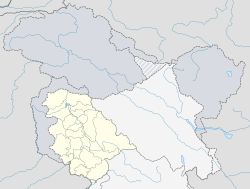Jourian
Jourian | |
|---|---|
Town | |
 Jourian Location in Jammu and Kashmir, India | |
| Coordinates: 32°50′02″N 74°34′37″E / 32.834°N 74.577°ECoordinates: 32°50′02″N 74°34′37″E / 32.834°N 74.577°E | |
| Country | |
| Union Territory | Jammu and Kashmir |
| District | Jammu |
| Elevation | 274 m (899 ft) |
| Population (2001) | |
| • Total | 3,628 |
| Languages | |
| • Official | Dogri, Hindi, English, Kashmiri, Urdu[1][2] |
| Time zone | UTC+5:30 (IST) |
| PIN | 181202 |
Jourian is a town and a notified area committee in Jammu district in the Indian union territory of Jammu and Kashmir.
Geography[]
Jourian is located at 32°50′N 74°35′E / 32.83°N 74.58°E.[3] It has an average elevation of 274 metres (899 feet).
History[]
This section does not cite any sources. (September 2018) |
Town was established by Sh Mustafa Khan, Jagirdhar of RakhDhok which is approximately 5 to 6 km north of Jourian. The Jagirdhar had their land limit up to Jourian which is north side of mighty River Chenab is plain and fertile as compare to Rakhdhok which is Kandi Area and less fertile. In 1903, the north Punjab was engulfed with the havoc of plague and it also effected adjoining areas. It was in the end of Apr /Beginning of May 1903 when there was a big rain falls with hailstorms (Aan) which destroyed the wheat crops resulting the rats died insides the huts/kacha houses with the results plague spread. The GrandMother of Sh Mustafa Khan came to Jourian where they have already a temporary (Kula) Shelter in order to avoid havoc of plague. The temporary shelter came into permanent shelter as the land of Jourian was more fertile and near the River, so there was no scarcity of water. Sh Mustafa Khan constructed the pucca Well few feet east of Masjid near to his house and decided to live at Jourian. That was the beginning of a town which is called Jourian. Later, when it was felt by young Sh Mustafa Khan to create the Jourian a Town. He called Shri Nand Shah (Father of Bhagwan Shah and Sita Ram ji), Father of Munshi Shah, Roulu Shah (father of Krishan Shah, Ganesh ,Rama, Kaindu and Rattan) from Kaleeth to settle at Jourian and start business. Shri Nand Shah was the friend of Sh Mustafa Khan. Sh Nandu Bhagat, Lambardar who also belongs from Rakhdhok shifted to Jourian on the request of Sh Mustafa Khan. Sh Moti Bhagat Father of Sh Shatu Ram, Sh Sangaru, Sh Guran Ditta and Sh Khikru called from Ajjal Mallal. Sh Nanku Bhagat Father of Sh Kartar Chand also from Panjigrain was called to settle at Jourian. Sh Manna Ram Chamar father of Munshi Ram from Potha which is hardly less than 2 km was also called to settle at Jourian. Sh Ishwar Dass and Badri Nath called from Setrial. Sh Nanku Mahajan Father of Sh Banarsi and Birta Ram also called from Potha. Sh Billo and Basanata Lohar were called from Chamb. Some Banias which are still called Bakoria came from Bakore. In addition to this Nandu Barawala also called from Gher.[citation needed]
Demographics[]
Religion in Jourian Town (2011)[4]
As of 2001 India census,[5] Jourian had a population of 3628. Males constitute 51% of the population and females 49%. Jourian has an average literacy rate of 75%, higher than the national average of 59.5%: male literacy is 81%, and female literacy is 68%. In Jourian, 12% of the population is under 6 years of age.
In the 2011 census 97.20% of residents were Hindu, 0.69% were Sikh and 0.81% were Muslim.[6]
See also[]
- Jammu
- Jammu Tawi railway station
- Talab Tillo
- Samba, Jammu
- Nagrota
- Kathua
- Jammu Cantonment
- Hiranagar
- Akhnoor
References[]
- ^ "The Jammu and Kashmir Official Languages Act, 2020" (PDF). The Gazette of India. 27 September 2020. Retrieved 27 September 2020.
- ^ "Parliament passes JK Official Languages Bill, 2020". Rising Kashmir. 23 September 2020. Retrieved 23 September 2020.
- ^ Falling Rain Genomics, Inc - Jourian
- ^ "Jourian Town Population". Census India. Retrieved 11 July 2021.
- ^ "Census of India 2001: Data from the 2001 Census, including cities, villages and towns (Provisional)". Census Commission of India. Archived from the original on 16 June 2004. Retrieved 1 November 2008.
- ^ http://www.census2011.co.in
- Cities and towns in Jammu district

